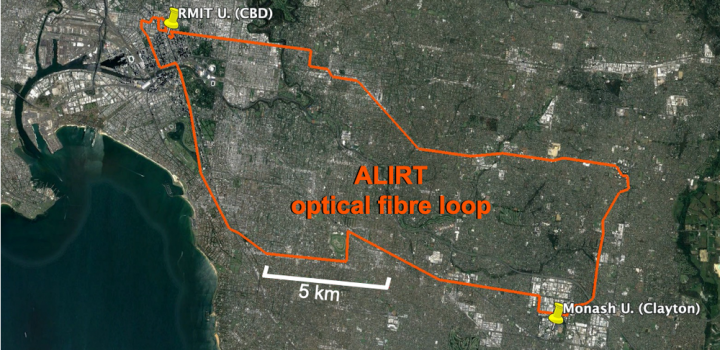
Researchers from RMIT, Monash and Swinburne universities have achieved the world’s fastest internet data speed - enough to download 1000 HD movies in a split second - using a single optical chip.
The ground-breaking results published in Nature Communications could fast-track Australia’s telecommunications capacity and that of other countries also struggling with demand on internet infrastructure.
The research team led by Monash University’s Dr Bill Corcoran, RMIT’s Distinguished Professor Arnan Mitchell and Swinburne’s Professor David Moss recorded a data speed of 44.2 Terabits per second (Tbps) from a single light source.
Importantly, said Mitchell, these speeds were achieved by attaching their new device to existing fibre-optic technology like that used across Australia's National Broadband Network (NBN).
He said the future ambition of the project was to scale up the current transmitters from hundreds of gigabytes per second towards tens of terabytes per second without increasing size, weight or cost.
“Long-term, we hope to create integrated photonic chips that could enable this sort of data rate to be achieved across existing optical fibre links with minimal cost,” Mitchell said.
“Initially, these would be attractive for ultra-high speed communications between data centres. However, we could imagine this technology becoming sufficiently low cost and compact that it could be deployed for commercial use by the general public in cities across the world.”
How it works
Optical fibres like those used in the NBN transmit data on pulses of light.
The team's new device, known as an optical micro-comb, creates a rainbow of infrared light allowing data to be transmitted on many frequencies of light at the same time, vastly increasing bandwidth.
Micro-combs had not been used in a field trials before this study, when researchers placed the fingernail-sized chip – contributed by Swinburne University – onto optical fibres and sent maximum data down each channel to simulate peak internet usage.
That's when it reached whopping data speeds of 40 Tbps: about three times the record data rate for the entire NBN network and about 100 times the speed of any single device currently used in Australian fibre networks.
Out of the lab and into the testbed
Demonstrations of this magnitude are usually confined to a laboratory.
Significantly, this was tested on 76.6km of ‘dark’ optical fibres between RMIT’s Melbourne City Campus and Monash University’s Clayton Campus.
The fibre loop is part of the Australian Lightwave Infrastructure Research Testbed (ALIRT) established with investment from the Australian Research Council by a consortium led by Mitchell.
The testbed allows researchers to investigate innovative new approaches to continually increase the amount the data capacity of existing optical fibre networks.
“Having RMIT University as the central node of this world-leading communications testbed gives us insight into the challenges and opportunities for next generation fibre optic communications in a real-world setting,” Mitchell said.
“It also gives us the ability to rapidly test new ideas.”
A solution for the world’s insatiable demand for bandwidth?
Corcoran, co-lead author of the study and Lecturer in Electrical and Computer Systems Engineering at Monash University, said the unprecedented number of people using the internet for remote work, socialising and streaming during coronavirus lockdowns around the world gave us a sneak-peak of how normal demand for internet infrastructure will look in two to three years’ time.
“It’s really showing us that we need to be able to scale the capacity of our internet connections,” he said.
“What our research demonstrates is the ability for fibres that we already have in the ground, thanks to the National Broadband Network (NBN), to be the backbone of communications networks now and into the future. We’ve developed something that is scalable to meet future needs.”
“And it’s not just Netflix we’re talking about here – it’s the broader scale of what we use our communication networks for. This data can be used for self-driving cars and future transportation and it can help the medicine, education, finance and e-commerce industries, as well as enable us to read with our grandchildren from kilometres away.”
Moss, Director of the Optical Sciences Centre at Swinburne University, said in the 10 years since he co-invented micro-comb chips, they had become an enormously important field of research.
“It is truly exciting to see their capability in ultra-high bandwidth fibre optic telecommunications coming to fruition. This work represents a world-record for bandwidth down a single optical fibre from a single chip source, and represents an enormous breakthrough for part of the network which does the heaviest lifting. Micro-combs offer enormous promise for us to meet the world’s insatiable demand for bandwidth.”
